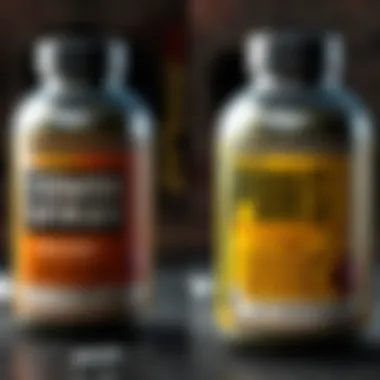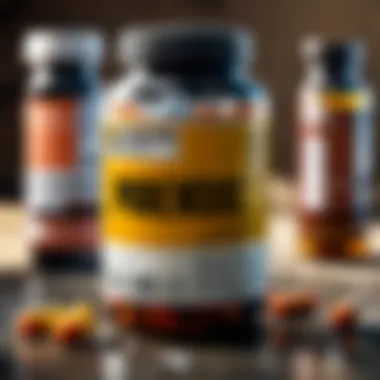Strategic Implementation of Faux Prescription Labels


Intro
Faux prescription labels have carved a niche within the field of medication containers, often tucked into the corners of pharmacy display cases or neatly adhered to the sides of over-the-counter products. Few might realize the underlying strategy behind their deployment. This article dives into the world of faux labels, unraveling their multifaceted uses across diverse industries, with a spotlight on medication containers where such labels have become a talking point.
Understanding the purpose of these labels extends beyond their aesthetic appeal. They often serve as tools for marketing, education, and, at times, misdirection. By examining the potential benefits, the ethical considerations, and the regulatory frameworks surrounding these labels, this exploration aims to provide a comprehensive guide that holds weight in both practicality and responsibility.
The landscape of health-related information is turbulent, with consumers overwhelmed by choices and conflicting messages. Faux prescription labels can bridge certain gaps by packaging information in a format that feels familiar and trustworthy. However, this appropriation of medical aesthetics raises ethical questions, particularly around consumer rights and informed decision-making. Balancing these elements will be a cornerstone of our discussion, and it’s crucial to address where the lines should be drawn.
Ultimately, this investigation not only highlights the strategic use of faux prescription labels but also unfolds the narrative of how they can align with contemporary needs while navigating complex regulatory environments. As we proceed through the article, insights gained will illuminate the functional roles these labels can occupy in our lives today.
Intro to Faux Prescription Labels
The strategic implementation of faux prescription labels in medication containers offers a unique glimpse into how design and functionality can intertwine. These labels, intended to resemble authentic pharmaceutical prescriptions, serve various important purposes in healthcare and beyond. Understanding the nuances of faux prescription labels is essential not only for practitioners in the medicine field but also for industries leveraging these tactics to enhance their product appeal.
Defining Faux Prescription Labels
Faux prescription labels can be described as non-official or imitation labels that imitate standard prescription formats typically utilized in the healthcare industry. They are usually designed to provide essential information regarding medication but do not correspond to a legitimate prescription or a specific medication. These labels can include details such as fictitious medication names, dosages, and usage instructions, which intend to simulate a real prescription experience. This phenomenon can be beneficial in various contexts, including marketing strategies, educational purposes, or patient engagement efforts. Additionally, they can provide a sense of legitimacy, giving consumers or patients the confidence that they are handling a product that is well-documented and trustworthy.
Historical Context
The use of faux prescription labels isn't entirely new. A cursory look at history reveals alterations and adaptations in pharmaceutical packaging have been around for ages. For instance, during the early 20th century, the practice of using artistic, colorful labels helped elevate the perceived value of products and build a connection with consumers. This practice evolved over the decades, but the foundation remained: people are influenced by the way information is presented.
As design methodologies have advanced, so too have the applications of faux prescription labels. With the rise of digital technology and graphic design tools, creating compelling faux designs has never been easier. They have found a place in marketing and branding strategies across numerous industries, capitalizing on consumer trust and familiarity with medical design aspects. This evolution underscores a broader societal trend where health-related imagery and practices are often co-opted by other sectors, blending the lines between safety, effectiveness, and commercialism.
By delving into the trajectory and usage of faux prescription labels, one can appreciate the complexities surrounding their role in modern society. Not only do they facilitate certain marketing avenues, but they also open up discussions on ethics, regulation, and consumer perception, which will be explored further in this article.
Purpose and Functionality
The purpose of adding faux prescription labels to medication containers unfolds as a critical aspect in the conversation about how we interact with medication in various contexts. These labels do more than just provide a decorative touch; they serve vital functions that enhance user experience and improve overall medication management.
Enhancing User Experience
First and foremost, faux prescription labels address usability. They can transform the seemingly mundane task of handling medications into a more engaging and informative experience for patients. A well-designed label can include clearer instructions, potentially reducing the risk of misuse. For instance, a label might feature easy-to-read fonts and color-coding, allowing users to instantly grasp critical information without squinting at small print.
Moreover, these labels also evoke a sense of professionalism. When patients see packaging that resembles an authentic prescription, it often instills confidence. They may feel reassured that they are dealing with a legitimate product. In a world where counterfeit medications can pose real dangers, making faux labels mimic standard prescriptions can help establish trust in the product, but it also raises some alarms. They might feel more comfortable asking questions, thereby improving interaction with healthcare providers.
Finally, communities that are underserved, whether it's economically or through lack of access to healthcare resources, can find faux prescription labels to be a useful tool. By enhancing user experience with these labels, healthcare providers or organizations can communicate vital health information more effectively. This boosts understanding and compliance among diverse demographics in today's multicultural landscape.
Facilitating Medication Management
When we dive into facilitating medication management, the role of faux prescription labels becomes even clearer. These labels can be tailored to meet the specific needs of diverse users, acting almost like a customized guide for taking their medications correctly.
Consider age and cognitive abilities; for example, older adults may find traditional prescriptions daunting due to their complexity. Faux labels can be simplified — stripping down jargon and using plain language instead. Icons denoting day/night dosing or reminders about potential interactions can significantly lower the barrier to proper medication adherence.


Additionally, faux labels can include features like dose tracking. An array of colored check boxes for each day of the week can help patients keep tabs on what they’ve taken and what’s left, almost like a scoreboard in a gaming app. Using visual aids and trackers bolsters accountability for self-care and supports patients on their path to better health.
"Faux prescription labels serve as informative guides, greatly reducing misunderstandings, and fostering better communication around medication."
In the context of chronic diseases where medications change frequently, employing faux prescription labels can ease the transition. These labels make it easy to incorporate vital information that shifts alongside treatment protocols. Keeping users informed could very well mean the difference between health crisis and health maintenance.
Ultimately, the intersection of user experience and medication management brings to light the multifaceted roles that faux prescription labels can play. While they seem deceptively straightforward, their strategic use can yield profound benefits in various healthcare scenarios and even trickle down into community health improvements.
Applications in Healthcare
The use of faux prescription labels in healthcare contexts stretches far beyond mere aesthetics. They play a crucial role in enhancing user engagement, streamlining processes, and ensuring patient safety. As we delve into the applications in healthcare, it becomes evident that these labels can add significant value without compromising ethical standards or regulatory guidelines.
Pharmaceutical Industry Uses
In the pharmaceutical sector, faux prescription labels can serve multiple purposes. Primarily, they provide an effective way to communicate essential information to patients in an easily digestible format. Imagine a medication bottle for a hypertension drug featuring a faux label that outlines dosage guidelines in a simple, straightforward manner, making it less likely for patients to misinterpret instructions.
Moreover, these labels can enhance the marketing strategy of a drug. By creating an attractive, informative label, pharmaceutical companies can boost consumer confidence and product recall. Using recognizable colors and fonts can invoke a sense of familiarity and trust. This approach can be particularly important when introducing new medications into the market.
- Brand Visibility: Faux labels assist in brand visibility by creating a cohesive look that ties in with other marketing materials.
- Patient Education: With effective labeling, healthcare providers can educate patients about the effects and possible side effects of medications directly on the package.
Additionally, faux prescription labels can help streamline the inventory management of pharmacies. By labeling stock with both informational and marketing components, pharmacies enhance their operational efficiency, aiding pharmacists in maintaining accurate records of what’s on hand. This utility cannot be understated in a busy pharmacy setting where time is of the essence.
Patient Adherence Improvisation
Patient adherence remains a perennial challenge within healthcare. Here, the applications of faux prescription labels truly shine. An engaging, clearly labeled medication container can significantly affect how patients interact with their prescribed medications. For instance, when a patient picks up a bottle with an eye-catching label that conveys clear and straightforward usage instructions, it can impact their willingness to follow the prescribed regimen.
The psychological impact of presentation should not be overlooked. A well-designed faux label can make the medication feel more legitimate or of higher quality, potentially increasing a patient’s willingness to use it as directed. This can be particularly true for younger patients or those navigating complex medication schedules.
"Clear labeling dramatically enhances the experience, simplifying the path to better patient compliance and overall health outcomes."
Moreover, faux prescription labels can facilitate the use of reminder systems. Imagine if patients received a medication with a label that not only instructs them when to take their next dose but also includes a QR code leading to a medication tracking app. This not only fosters adherence but also positions the medication as part of a broader wellness journey, reinforcing healthy habits.
In summary, faux prescription labels present an array of opportunities within healthcare. From bolstering pharmaceutical marketing to improving patient adherence, their strategic use can unlock valuable benefits that translate to better health outcomes. As the healthcare landscape continues to evolve, understanding the tactical application of faux labels becomes increasingly important in maintaining a high standard of care.
Cross-Industry Applications
In today's marketplace, the strategic use of faux prescription labels extends beyond the pharmacy aisles, crossing over into multiple industries. These labels wield considerable influence, not only enhancing user experiences but also reshaping marketing approaches and promotional tactics in sectors such as consumer goods and branding. This section elucidates on how faux prescription labels are becoming a hot commodity across various sectors, revealing their potential benefits and the nuances involved in their adoption.
Marketing and Branding Strategies
Faux prescription labels have found their way into the marketing strategies of diverse brands, acting as unique conversation starters and attention-grabbers. Companies are leveraging these labels to project an image of authenticity and trustworthiness, mimicking the aesthetics of real medication labels. This strategy can appeal particularly to consumers who appreciate novelty and a fresh spin on branding.
Not just a gimmick, their design can evoke feelings of safety and reliability when done right. For example, some health-focused snack companies or wellness brands might use faux labels to reinforce their commitment to health, presenting their products as backed by expertise. This approach can create a perceived credibility that encourages consumers to buy into the product's narrative.
Moreover, brands can harness this visual cue effectively in their advertising campaigns, utilizing it to draw parallels between their products and those in traditional medical or health environments.


Here are some key elements to consider for companies aiming to implement faux prescription labels:
- Visual Aesthetics: Ensure the design mimics genuine prescription labels without crossing into illegality.
- Brand Messaging: Align the label text with the overall brand voice and ensure it communicates the right message.
- Target Audience Engagement: Understand what messaging resonates with your primary consumer base, primarily focusing on settings where health and wellness are prioritized.
Consumer Products Adaptation
Adapting faux prescription labels in consumer products is not merely a matter of aesthetics; it involves a deeper understanding of consumer behavior and market trends. The rise of health consciousness among consumers has made it imperative for brands to adapt their products accordingly. Faux prescription labels can serve as a bridge, linking health-focused consumer goods to the credibility often associated with the pharmaceutical industry.
For instance, brands selling vitamin supplements or organic snacks might utilize faux labels to imitate the traditional look of prescribed medication, which may influence purchasing decisions by fostering a perception of scientific backing. This does not just enhance aesthetic appeal; it also takes advantage of psychological triggers associated with prescription medications, such as efficacy and safety.
Furthermore, such adaptation has implications for cross-promotion as well. Products featuring faux prescription labels can be marketed alongside genuine healthcare products, creating unique synergies. This cross-industry dialogue facilitates a modern amalgamation of consumer health products, often resulting in increased consumer awareness and the potential for broader market reach.
To sum up, the use of faux prescription labels in various industries signals a significant transformation in how products are marketed. As brands adapt to this trend, understanding the balance between creativity and ethical considerations will be paramount. The this approach not only invites curiosity but potentially changes consumer's perception of product credibility, ultimately encouraging both purchase and loyalty.
Legal and Ethical Considerations
Faux prescription labels, while beneficial in many respects, also bring forward a host of legal and ethical considerations that must be thoughtfully addressed. Understanding these areas is crucial because they not only shape how such labels can be utilized but also influence public perception regarding their legitimacy and safety. By diving into the regulatory and ethical frameworks surrounding faux labels, we can better appreciate their potential consequences.
Regulatory Compliance
Compliance with existing laws and regulations is paramount for the use of faux prescription labels. Regulatory bodies, such as the U.S. Food and Drug Administration (FDA), lay down specific guidelines pertaining to how medications and their representations should be handled. Failure to comply can lead to severe penalties, including fines or more damaging effects on a company’s reputation.
Firstly, it is vital to distinguish between marketing tactics that are allowed and those that are deemed misleading or fraudulent. Faux labels must not misrepresent the product contained within the packaging or the intended use of the medication. For example, attaching a label that falsely claims a prescription status could mislead consumers and, in worst cases, jeopardize patient safety. Furthermore, companies must ensure that these labels do not infringe upon intellectual property rights or misappropriate professional endorsements.
- Key points:
- Adhering to FDA guidelines
- Understanding consumer safety laws
- Avoiding misleading claims
It is also important to ensure that any faux labeling practices align with state laws, which can vary significantly across jurisdictions. Consultation with legal experts specializing in healthcare regulations is recommended to navigate these complexities effectively.
Ethical Implications
The ethical implications regarding faux prescription labels are equally significant, demanding a careful balance between marketing innovation and consumer protection. One of the primary concerns is the risk of obfuscating the context of medication. If consumers perceive a faux label as genuine, they may misunderstand the serious nature of the product, leading to misuse or over-reliance on non-prescribed medications. This is particularly problematic in settings where mental health or chronic issues are prevalent.
Moreover, there arises an ethical dilemma around transparency. Companies deploying faux prescription labels should consider the long-term impacts on their relationship with their customers. Misleading practices can breed distrust, ultimately leading to a more skeptical consumer base that questions the integrity of the entire industry.
"Marketing strategies must align with ethical responsibility to ensure customer trust remains intact."
- Considerations include:
- The potential to misguide patients
- Issues regarding informed consumer choices
- Long-term effects on brand reputation
Challenges in Implementation
The implementation of faux prescription labels is not without its hurdles. Understanding these challenges is essential for the successful integration of these labels across numerous sectors, particularly in realms like healthcare and consumer products. The discussion centers on two critical elements: public perception and the risk of misuse. Exploring these facets reveals why a cautious, well-informed approach is of paramount importance.


Public Perception and Misunderstanding
Public perception plays a pivotal role in the deployment of faux prescription labels. Much hinges on how these labels are viewed by the average person and how misinformation can spiral out of control. With any healthcare-related issue, the community tends to be sensitive. Misunderstandings surrounding faux prescription labels can spark confusion, leading individuals to doubt the legitimacy of their medications or even dismiss them entirely.
For example, consider the scenario of a patient receiving a prescription container with a faux label featuring alarming symptoms associated with a medication. If the label is misinterpreted, it can induce unnecessary anxiety, causing patients to abandon the treatment altogether. One way to combat this phenomenon is through educational campaigns that elucidate the purpose behind faux labels and how they can be beneficial rather than detrimental.
"Education is the most powerful weapon which you can use to change the world." – Nelson Mandela
These campaigns could involve collaboration with healthcare providers and community organizations to clarify the intent behind these labels. This proactive approach can forge a pathway to greater understanding and acceptance among patients.
Risk of Misuse
Another significant challenge tied to using faux prescription labels is the potential for misuse. This concern isn't just hypothetical; it carries heavy real-world implications. The very nature of faux labels may make them appealing for nefarious activities, especially for individuals seeking to exploit vulnerabilities in prescription medications.
Imagine a scenario where faux prescription labels end up on containers of illegal substances, mimicking authorized medications. This may lead consumers to confuse genuine pharmaceutical products with dangerous counterfeits. Consequently, this can result in health crises and a loss of trust in legitimate healthcare practices.
To mitigate this risk, stringent guidelines should be developed. These guidelines may involve oversight from regulatory bodies to ensure that faux labels are utilized only for appropriate applications. Additional steps could involve training for manufacturers and distributors, emphasizing the ethical responsibility tied to their use.
Moreover, transparency is crucial in any regulatory framework. Patients should be informed about the nature of faux labels, allowing them to discern useful information from misleading markings. Only then can the full potential of faux labels be realized while safeguarding public health and trust in healthcare systems.
Future Directions
As the landscape for medication management continues to evolve, examining the future directions of faux prescription labels becomes imperative. These labels are not merely a novelty; they hold potential for enhancing user experience, ensuring better medication adherence, and navigating the complexities of health information transfer. Embracing innovative approaches will be key as industries adapt to novel challenges and expectations from users. Below are key areas to consider in the coming years.
Technological Integration
In an era dominated by rapid technological advancements, integrating digital solutions with faux prescription labels could revolutionize the way patients interact with their medications. For instance, incorporating augmented reality features could allow users to scan labels with their smartphones, revealing vital information such as dosage instructions, side effects, and expiration dates in a user-friendly format.
- Customizable Features: Imagine users being able to tailor the display on the label based on personal preferences. For older adults or those with visual impairments, larger fonts and high-contrast colors could be enabled via an app.
- Real-Time Updates: Automated systems could periodically update the information on the label itself, notifying users of recalls or new drug interactions almost instantly.
This level of integration would not only bridge the gap between technology and healthcare but also enforce user engagement. Enhanced communication with regard to their medications may result in lower rates of medication errors.
Innovative Design Approaches
The aesthetic and functional design of faux prescription labels will also see a significant shift. As users crave a more meaningful connection with their medication, the design must speak to both functionality and emotional appeal.
- Visual Storytelling: Instead of traditional labels cluttered with jargon, designs that incorporate visuals and simple language can make the information less daunting. For example, using icons for each type of medication or the specific purpose can demystify the medicine for users of all ages.
- Sustainable Materials: There’s an increasing awareness of environmental concerns. Labels made from biodegradable materials not only communicate a brand's commitment to sustainability but also enhance the appeal to eco-conscious consumers.
Finale
The strategic implementation of faux prescription labels poses a significant intersection of usability and ethics within modern healthcare and beyond. Such labels serve various purposes, from enhancing user experience to streamlining medication management. As this article has showcased, their utility is evident across diverse applications, emphasizing the multifaceted benefits these labels can bring to both consumers and industries. Yet, it is imperative to weigh these advantages against legal and ethical considerations, especially as the misuse of faux labels could lead to misunderstandings that jeopardize health and trust.
In essence, it’s not merely about slapping a label on a container; it’s about ensuring these labels contribute to clearer communication regarding medication. The precision with which faux labels are created and used directly influences the user's comprehension and adherence to medical regimens. The insights revealed throughout the discourse underline the necessity for ongoing dialogue among manufacturers, regulators, and consumers, fostering a balanced approach that prioritizes safety while embracing innovation.
Summary of Key Insights
- Enhanced Clarity: Faux prescription labels can demystify medication instructions, aiding users in understanding complex treatment regimens.
- Adaptable Across Industries: These labels are not constrained to healthcare; they find applications in marketing, branding, and consumer products, illustrating their versatility.
- Regulatory Framework: Compliance with the legal standards surrounding faux labels is paramount. Understanding these regulations can help mitigate risks associated with their use.
- Ethical Dilemmas: The fine line between marketing and misrepresentation raises important ethical questions that warrant thoughtful consideration.
- Future Innovations: Technological advancements present an exciting frontier for better-designed faux labels, potentially utilizing QR codes or augmented reality to enhance user interaction.
Final Thoughts on Faux Labels
As we reflect on this topic, it becomes patently clear that the innovative potential of faux labels must never overshadow the responsibility to prioritize clarity and safety. The future might hold a realm where faux labels help bridge the gap between patients and providers, ensuring everyone is on the same page. For all individuals engaged in healthcare or consumer products, understanding this intricate dance between enhancement and ethics will be crucial moving forward.



